Spanish style front porches embody timeless Mediterranean elegance through warm terracotta tiles, graceful archways, and wrought iron accents. These welcoming entryways blend rustic charm with sophisticated design elements, creating inviting spaces that reflect centuries of architectural tradition. From classic stucco columns to vibrant hand-painted tiles, Spanish porches offer endless possibilities for transformation. Whether incorporating drought-tolerant landscaping, ornate metalwork, or cozy seating areas, these designs celebrate outdoor living while enhancing curb appeal. Each approach combines practical functionality with aesthetic beauty, ensuring your front porch becomes a stunning focal point that captures the essence of old-world Spanish charm.
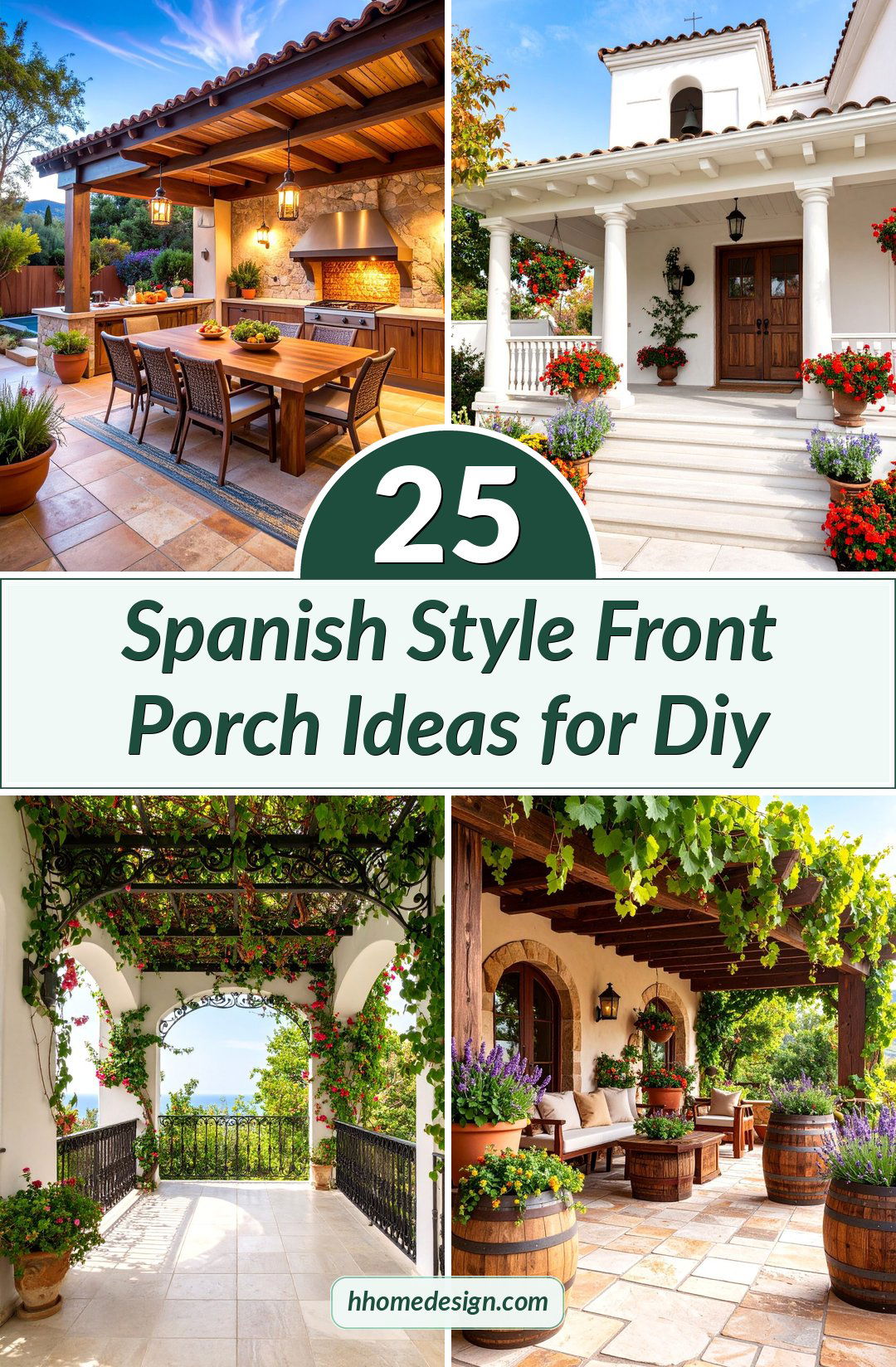
1. Classic Terracotta Tile Porch with Arched Colonnade

Transform your entrance with authentic terracotta flooring beneath graceful stucco arches supported by cylindrical columns. The warm, earthy tones of handmade clay tiles create a rustic foundation that perfectly complements white or cream-colored stucco walls. Install wrought iron hanging lanterns between each arch to cast dramatic shadows during evening hours. Add large terracotta planters filled with drought-tolerant succulents and lavender to frame the walkway. Complete the look with a heavy wooden door featuring decorative iron hardware and small glass panels. This timeless combination creates an authentic Spanish colonial atmosphere that welcomes guests with old-world elegance and Mediterranean warmth.
2. Wrought Iron Balcony Porch with Juliet Railings

Create dramatic vertical interest with an elevated front porch featuring ornate wrought iron Juliet balconies extending from upper-level windows. Install matching decorative railings along the main porch perimeter, incorporating traditional Spanish scrollwork patterns and geometric designs. Use natural stone or brick flooring to complement the dark metal accents, while white stucco walls provide a clean backdrop. Add climbing bougainvillea or jasmine vines to soften the metalwork and introduce vibrant colors. Position wrought iron furniture including a small bistro table and chairs for intimate seating. Illuminate the space with traditional Spanish lanterns mounted on the walls, creating an enchanting evening ambiance that showcases the intricate ironwork details.
3. Mediterranean Courtyard Entry with Central Fountain

Design an enclosed front courtyard that serves as a transitional space between the street and your home's entrance. Install a central tiered fountain as the focal point, surrounded by geometric planting beds filled with Mediterranean herbs like rosemary, thyme, and oregano. Use natural flagstone or limestone pavers arranged in traditional patterns, bordered by low stucco walls topped with decorative tiles. Create intimate seating areas with curved benches built into alcoves, providing spots for quiet contemplation. Frame the main entrance with an impressive archway featuring carved stone details. Add citrus trees in large glazed ceramic pots to introduce fragrance and seasonal interest while maintaining the authentic Spanish garden aesthetic.
4. Rustic Wooden Beam Porch with Exposed Vigas

Showcase traditional Spanish construction techniques with exposed wooden ceiling beams called vigas extending from the main structure. Install thick, rough-hewn timber posts to support the porch roof, leaving natural wood grain visible for authentic rustic appeal. Use Saltillo tiles for flooring, allowing their irregular surfaces and warm orange tones to enhance the handcrafted atmosphere. Add woven textiles in earth tones through outdoor cushions and throws placed on simple wooden furniture. Include copper or clay pendant lights suspended from the vigas to provide warm, ambient lighting. Complete the design with native plants in hand-thrown pottery, creating a harmonious blend of natural materials that reflects traditional Spanish hacienda style.
5. Colorful Talavera Tile Accent Porch

Incorporate vibrant hand-painted Mexican Talavera tiles as accent elements throughout your porch design. Use these decorative tiles on stair risers, planter boxes, and as borders around doorways and windows. Choose traditional patterns in blues, yellows, and greens against a neutral stucco background. Install plain terracotta floor tiles to provide a warm base that won't compete with the colorful accents. Add matching Talavera planters filled with bright flowers like geraniums and marigolds. Include wrought iron furniture with curved lines that echo the organic patterns in the tilework. String colorful paper lanterns or install ceramic sconces to enhance the festive, artistic atmosphere while celebrating Mexican craftsmanship within Spanish architectural traditions.
6. Stone Column Porch with Natural Materials
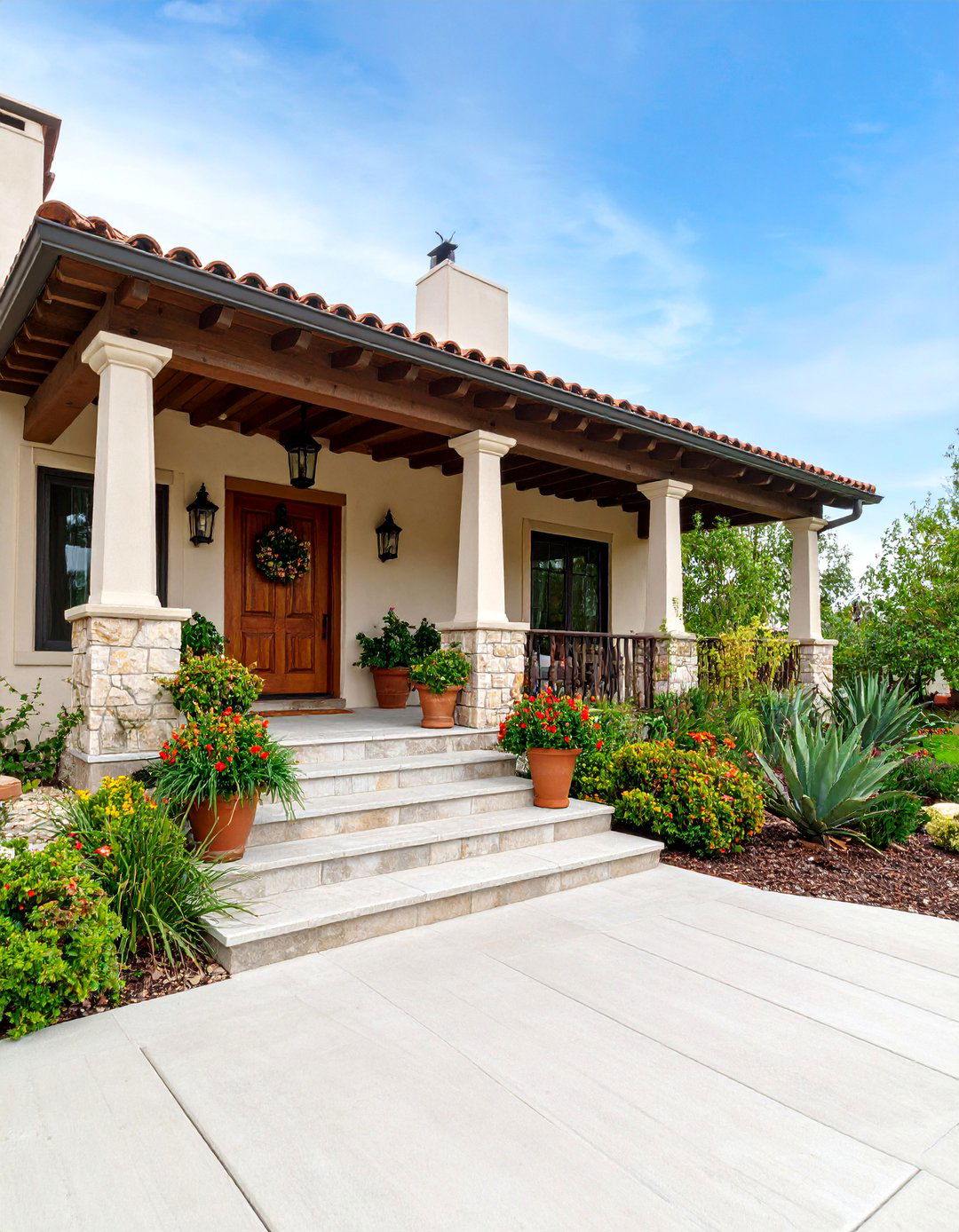
Build impressive porch columns using natural stone that reflects regional geology and adds substantial visual weight to your entrance. Choose limestone, sandstone, or local fieldstone for authentic texture and color variation. Create wide steps leading to the porch using the same stone material, establishing a solid foundation for the design. Install terra cotta roof tiles supported by wooden beams for overhead protection. Use decomposed granite or crushed stone for pathways, allowing for proper drainage while maintaining a natural appearance. Add drought-tolerant landscaping with agave, yucca, and ornamental grasses that complement the stone's earthy tones. Include simple wooden benches or stone seating built into low retaining walls for functional and aesthetic appeal.
7. Spanish Mission Style Bell Tower Porch
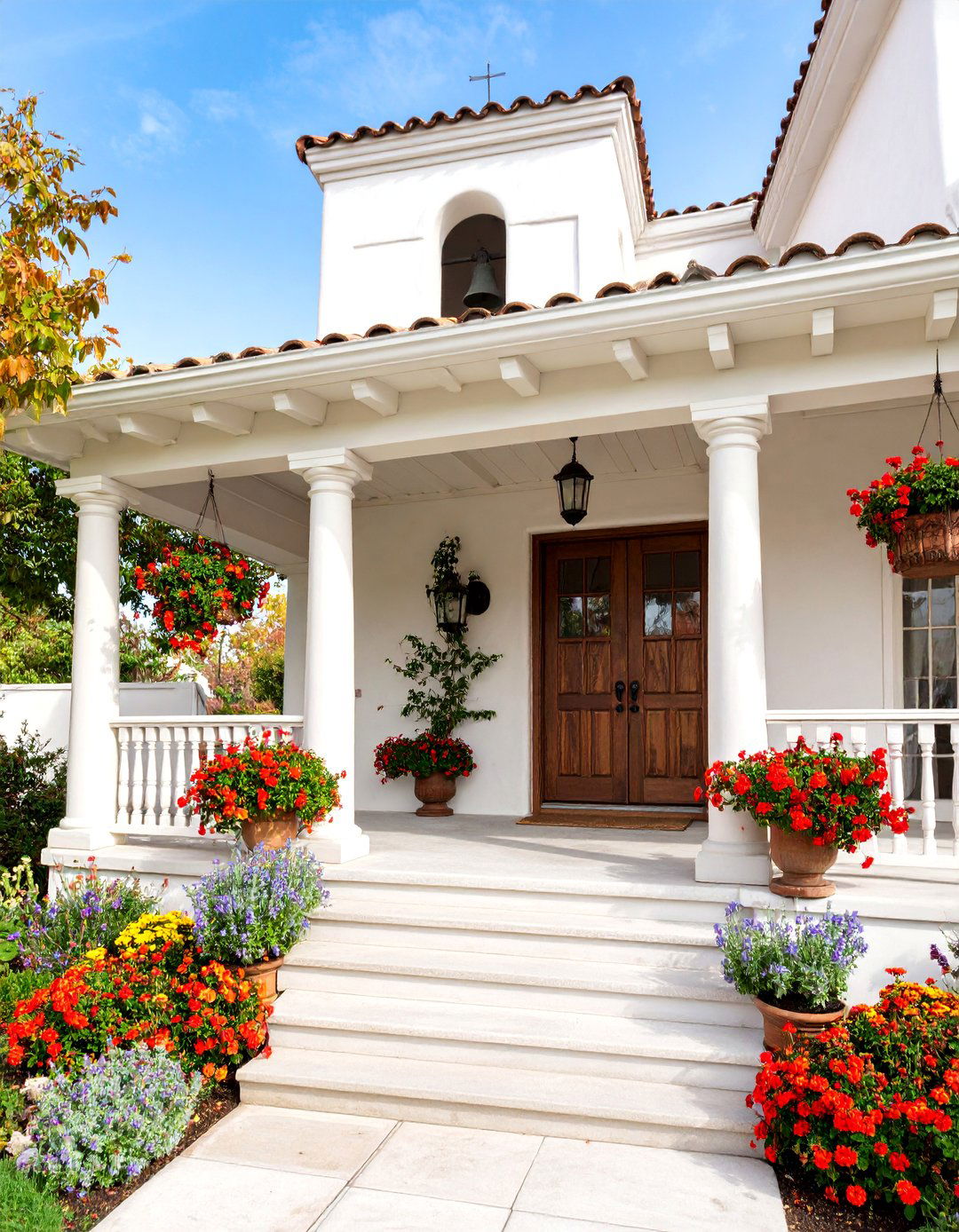
Create architectural drama with a distinctive bell tower feature incorporated into your porch design. Build a vertical element featuring traditional mission-style curves and arched openings that house decorative bells or lighting fixtures. Use smooth stucco finish in warm white or cream tones, accented with terracotta tile details around the arched openings. Install red clay barrel tiles on the bell tower roof and extend this material to cover the main porch area. Add thick stucco columns supporting heavy wooden beams for structural and visual balance. Include a large wooden door with iron hardware and small decorative windows. Landscape with olive trees and lavender to complete the mission aesthetic.
8. Pergola-Covered Porch with Climbing Vines
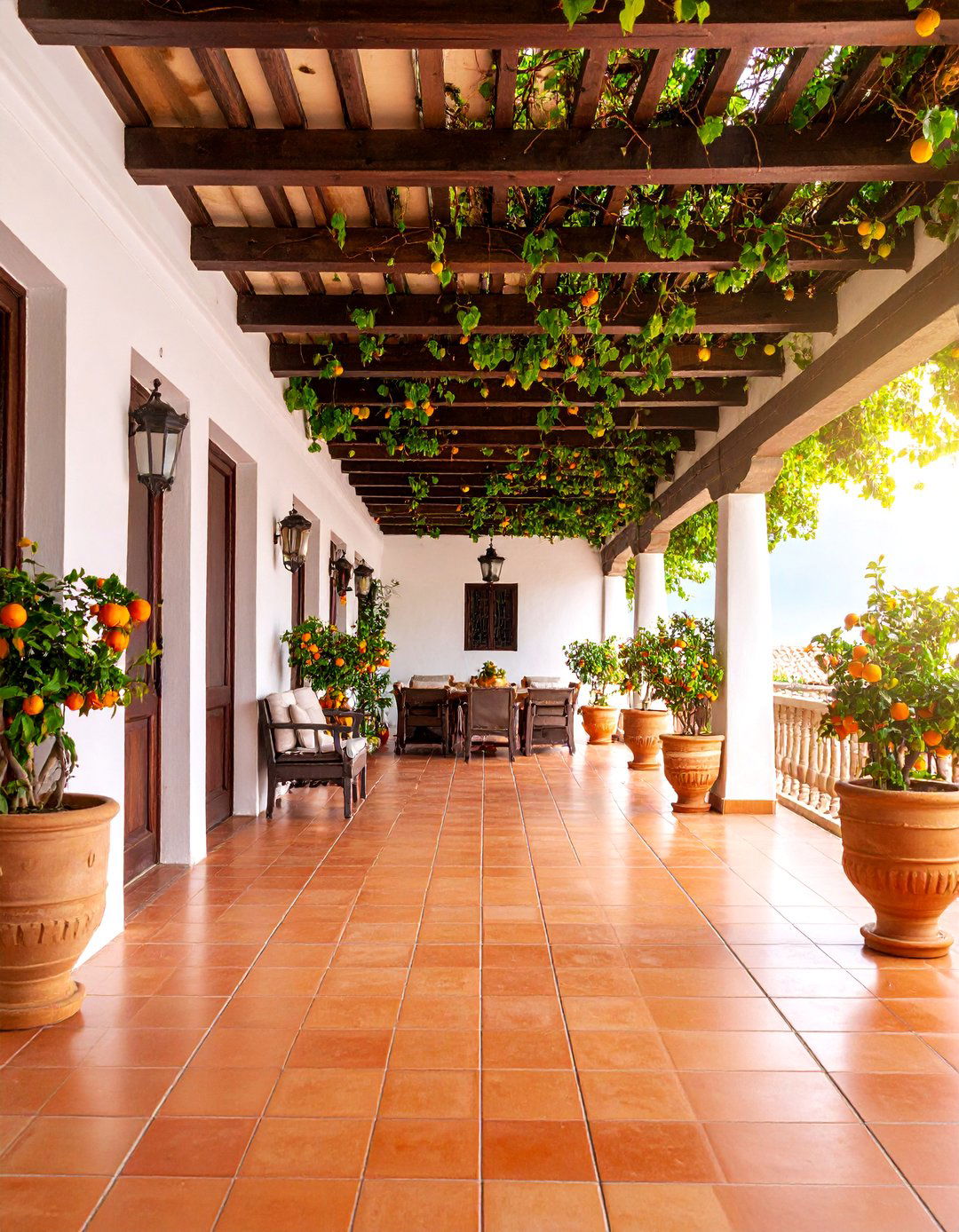
Install a traditional Spanish pergola featuring thick wooden beams and posts to create filtered shade over your front porch area. Allow climbing vines like grape, bougainvillea, or trumpet vine to grow over the structure, providing natural cooling and seasonal interest. Use large terracotta tiles or natural stone for flooring that can withstand occasional moisture from the overhead plantings. Add comfortable outdoor furniture including cushioned chairs and a low table for casual entertaining. Install discreet lighting within the pergola structure for evening use. Include large ceramic planters with Mediterranean plants like oleander and citrus trees. The combination of architectural structure and living elements creates a seamless integration between built and natural environments typical of Spanish garden design.
9. Moorish-Inspired Horseshoe Arch Porch
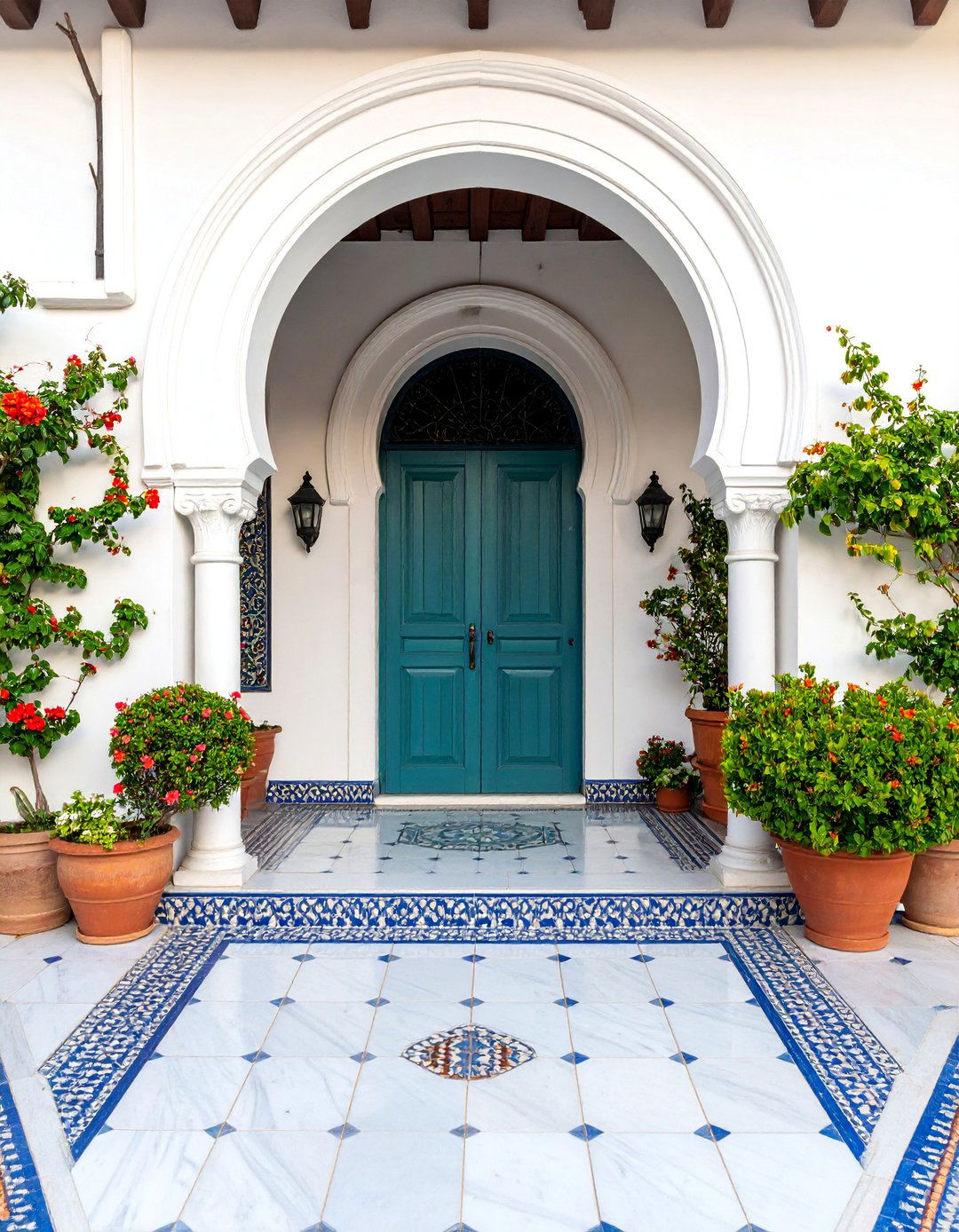
Incorporate the distinctive horseshoe arch characteristic of Moorish influence in Spanish architecture as the central feature of your porch entrance. Frame this dramatic arch with decorative tilework featuring geometric patterns in traditional blue and white or earth tones. Use marble or travertine flooring to complement the refined architectural details. Install ornate wrought iron gates within the arch opening for added security and visual interest. Add water elements such as wall-mounted fountains with intricate tile surrounds. Include formal plantings in symmetrical arrangements using boxwood, cypress, or other shaped evergreens in decorative planters. The sophisticated combination of Islamic-influenced architecture with traditional Spanish elements creates an elegant and culturally rich entrance that speaks to Spain's diverse historical influences.
10. Hacienda-Style Covered Corridor Porch

Design an extended covered walkway that connects different areas of your property while providing substantial front porch space. Support the long roof structure with a series of substantial posts or columns spaced at regular intervals. Use consistent materials throughout including stucco walls, terracotta tile flooring, and red clay roof tiles. Create multiple seating areas along the corridor using built-in benches or groupings of traditional furniture. Add decorative elements like ceramic tiles, wrought iron details, and hanging lanterns to break up the long expanse. Include planting beds along the outer edge with native plants and herbs. This expansive design reflects the grand scale of traditional Spanish haciendas while providing flexible outdoor living space.
11. Intimate Alcove Porch with Built-in Seating

Create a cozy retreat by designing your porch as a semi-enclosed alcove with built-in seating integrated into the architecture. Use stucco or stone to construct curved bench seating that follows the natural lines of the space. Add comfortable cushions in warm, textured fabrics that can withstand outdoor conditions. Install overhead beams for partial enclosure while maintaining openness to the front yard. Use decorative tiles for accent areas and natural stone or terracotta for flooring. Include intimate lighting through sconces or small hanging fixtures. Add planters with fragrant herbs and flowers within easy reach of the seating area. This design emphasizes comfort and relaxation while maintaining the authentic Spanish aesthetic through careful material selection and proportional relationships.
12. Desert-Adapted Xerophytic Garden Porch
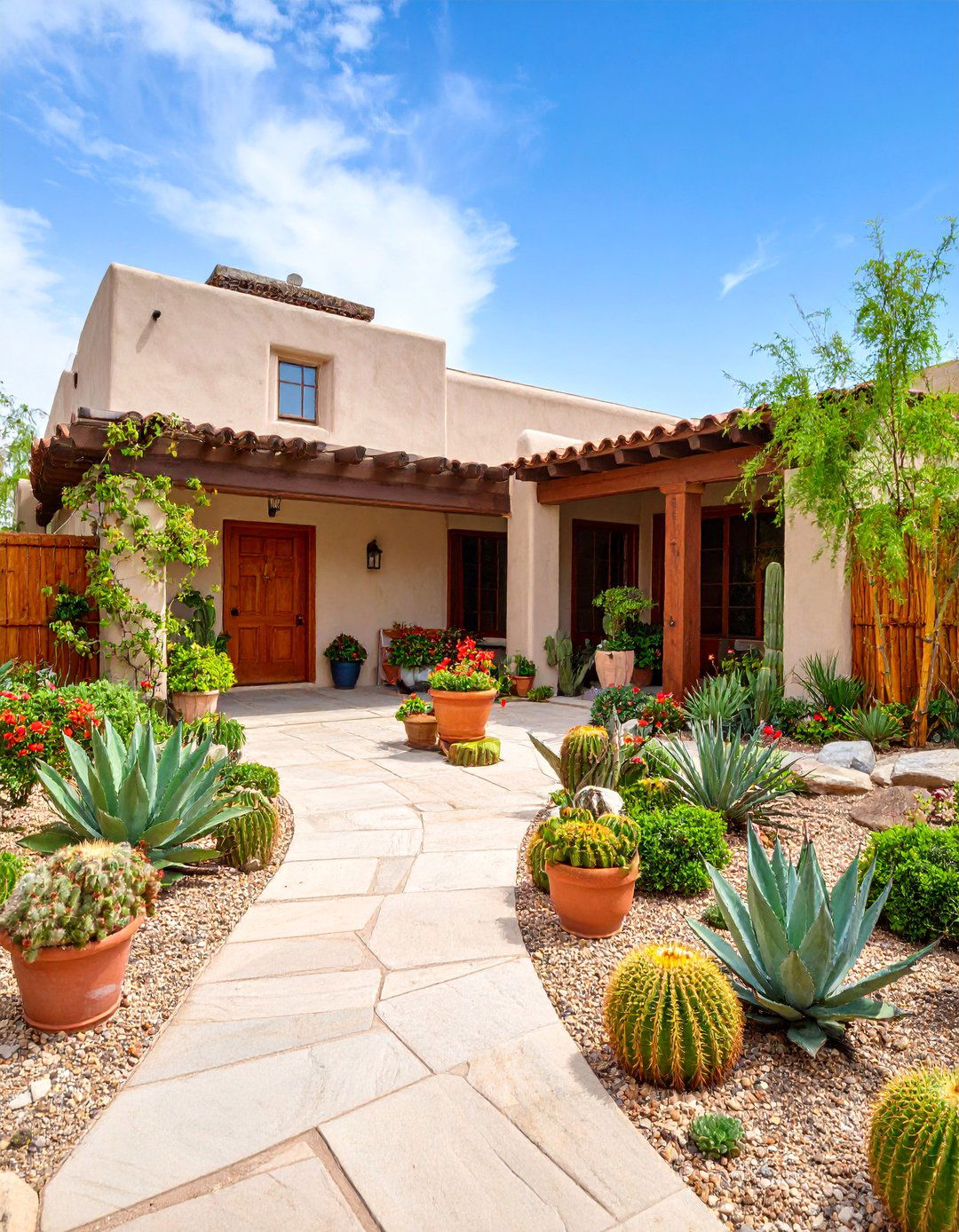
Embrace water-wise landscaping principles by surrounding your Spanish-style porch with drought-tolerant plants that thrive in arid conditions. Use decomposed granite pathways and gravel mulch around dramatic succulent plantings including barrel cacti, agave, and prickly pear. Install permeable paving materials like flagstone or permeable concrete for the porch surface. Add shade structures using natural materials like bamboo or reed screening. Include water-wise features such as a small contemporary fountain with minimal water usage. Choose furniture made from weather-resistant materials like teak or powder-coated metal. The landscape design celebrates the natural beauty of desert plants while the architectural elements maintain Spanish colonial character through appropriate material choices and proportional relationships.
13. Ceramic Mosaic Art Porch with Artistic Elements

Transform your porch into an artistic showcase featuring custom ceramic mosaic installations on walls, steps, and planters. Commission local artisans to create unique patterns inspired by traditional Spanish and Moorish designs using vibrant glazed tiles. Use neutral terracotta or stone flooring to provide a calm backdrop for the colorful artistic elements. Install gallery-style lighting to highlight the mosaic work during evening hours. Add sculptural elements like ceramic pottery or wrought iron artwork that complement the mosaic themes. Include comfortable seating positioned to appreciate the artistic details. Plant Mediterranean herbs and flowers that echo the colors used in the mosaic work. This approach celebrates Spanish artistic traditions while creating a unique, personalized entrance that reflects individual taste and cultural appreciation.
14. Two-Story Balcony Porch with Upper Gallery

Maximize vertical space by creating a dramatic two-level porch design featuring an upper balcony that extends over the main entrance area. Support the upper level with substantial columns or arches that create a grand colonnade effect. Use consistent materials throughout both levels including stucco walls, wrought iron railings, and terracotta tile accents. Install French doors or tall windows that open onto the upper balcony from interior rooms. Add climbing vines or hanging plants that cascade from the upper level to create vertical interest. Include appropriate furniture for both levels, considering different functions and privacy needs. The dramatic vertical emphasis creates impressive curb appeal while providing additional outdoor living space that captures the grandeur of Spanish colonial architecture.
15. Outdoor Kitchen Integration Porch
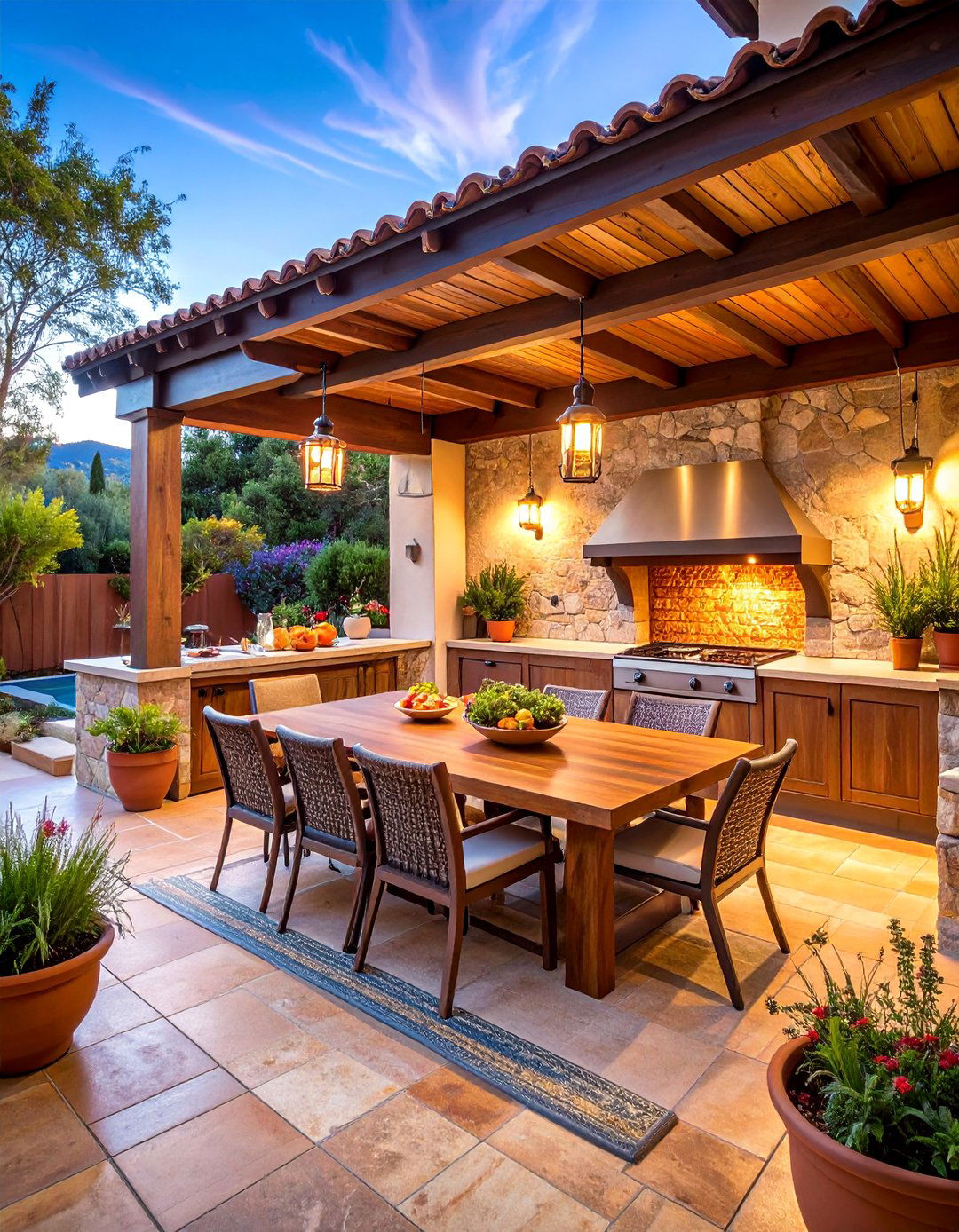
Combine your front porch with outdoor cooking facilities by incorporating a kitchen area that serves both practical and social functions. Install a wood-fired pizza oven or traditional Spanish-style outdoor fireplace as the centerpiece. Use durable materials like natural stone or stucco for countertops and cabinet bases. Include tile work featuring traditional patterns on backsplashes and decorative surfaces. Add a dining area with a substantial wooden table and chairs that can accommodate family gatherings. Install appropriate lighting for both cooking and dining activities. Include herb gardens in nearby planters for fresh cooking ingredients. The integration of cooking facilities with entrance architecture creates a uniquely Spanish approach to outdoor living that emphasizes hospitality and community gathering.
16. Fortress-Style Thick Wall Porch with Security Elements

Design a porch that emphasizes the defensive aspects of Spanish colonial architecture through substantial masonry construction and strategic openings. Build thick stucco or adobe-style walls that create a sense of security and permanence. Install heavy wooden doors with decorative iron hardware and small windows with protective grilles. Use natural stone or thick terracotta tiles for flooring that can withstand heavy use. Add built-in seating within wall niches for intimate conversation areas. Include defensive elements like arrow-slit windows or decorative battlements that reference historical fortress architecture. Plant thorny or dense shrubs that provide natural security while maintaining aesthetic appeal. The robust construction and thoughtful details create an impressive entrance that speaks to Spanish architectural traditions of strength and protection.
17. Wine Country Vineyard-Inspired Porch
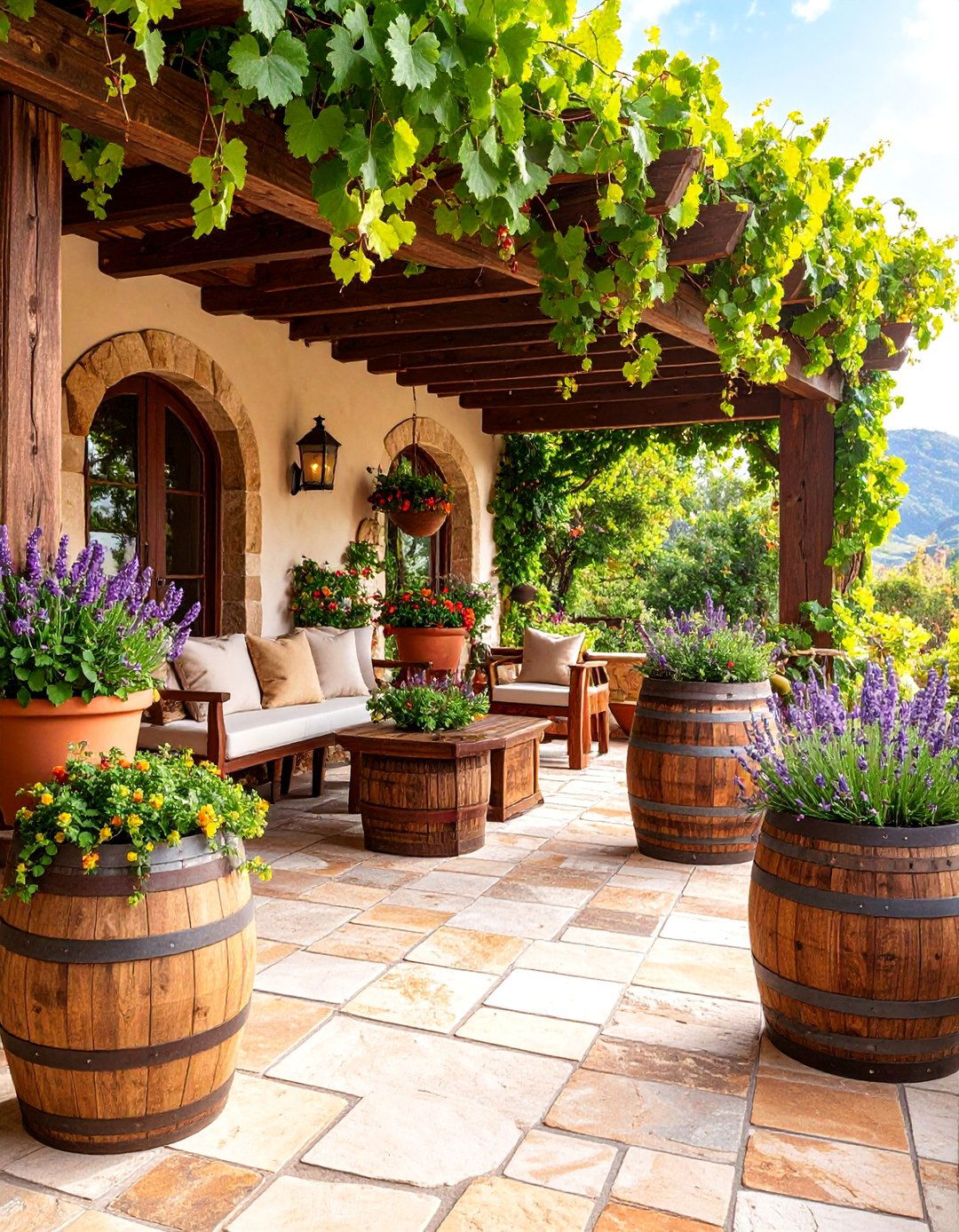
Create a porch design that celebrates Spanish wine-making traditions through architectural elements and landscaping choices. Install grape arbors or pergolas that can support actual grapevines or decorative equivalents. Use materials associated with wine production including reclaimed oak beams, natural stone, and terracotta elements. Add wine barrel planters filled with Mediterranean herbs and flowers. Include comfortable seating areas suitable for wine tasting or casual entertaining. Install subtle lighting that creates an intimate evening atmosphere. Plant lavender, rosemary, and other aromatic plants that complement wine country aesthetics. Add decorative elements like ceramic tiles featuring grape motifs or wine-related imagery. The design celebrates Spanish viticultural heritage while creating a relaxing entrance space that invites lingering and conversation.
18. Contemporary Minimalist Spanish Porch

Modernize traditional Spanish elements through clean lines and simplified details while maintaining cultural authenticity. Use large-format tiles in neutral colors for flooring and wall accents. Install sleek columns with minimal ornamentation supporting flat or gently sloped rooflines. Choose furniture with contemporary proportions but traditional materials like teak or wrought iron. Add geometric planters containing architectural plants like agave or olive trees. Include modern lighting fixtures that complement rather than compete with the architecture. Use a limited color palette focusing on whites, earth tones, and single accent colors. The restraint in decorative elements allows the quality of materials and proportional relationships to create visual interest while honoring Spanish design principles through contemporary interpretation.
19. Rustic Farmhouse Spanish Porch with Agricultural Elements

Blend Spanish colonial architecture with rural agricultural themes through the incorporation of farming-related materials and plantings. Use reclaimed materials like weathered wood beams and aged terracotta tiles that show natural patina and wear patterns. Install large planters containing edible plants like tomatoes, peppers, and herbs that reference Spanish culinary traditions. Add rustic furniture made from natural materials including rough-hewn wood and wrought iron. Include utilitarian elements like harvest baskets, ceramic water vessels, or traditional farming tools as decorative accents. Plant fruit trees or grapevines that provide both shade and seasonal interest. The design celebrates the agricultural heritage of Spanish culture while creating a practical and inviting entrance that connects inhabitants with traditional food production.
20. Artistic Blacksmith Ironwork Showcase Porch

Feature custom wrought iron work as the primary decorative element throughout your porch design. Commission local blacksmiths to create unique railings, gates, light fixtures, and decorative panels that showcase traditional Spanish metalworking techniques. Use simple stucco backgrounds that allow the ironwork to take center stage. Install spotlighting that creates dramatic shadows and highlights the intricate metalwork details. Add furniture pieces that coordinate with the custom ironwork including chairs, tables, and planters with matching design elements. Include plants with strong architectural forms that complement the geometric patterns in the metalwork. The emphasis on handcrafted iron elements celebrates Spanish artisanal traditions while creating a unique and personalized entrance that demonstrates appreciation for traditional craftsmanship.
21. Stained Glass Accent Porch with Colored Light

Incorporate traditional Spanish stained glass elements through windows, door panels, and decorative screens that create beautiful colored light effects. Use traditional patterns and colors including deep blues, reds, and golds that reference Spanish ecclesiastical and domestic traditions. Install protective coverings that allow the glass to be appreciated while preventing damage. Add lighting behind the glass elements to create dramatic effects during evening hours. Use neutral materials for walls and flooring that provide appropriate backgrounds for the colorful glass work. Include furniture and plantings that complement the colors used in the glass designs. The integration of stained glass elements adds spiritual and artistic dimensions to the entrance while celebrating Spanish cultural heritage through traditional craft techniques.
22. Multi-Level Terraced Porch with Steps and Platforms

Create dynamic visual interest through multiple levels that accommodate sloping terrain while providing various outdoor spaces for different activities. Build retaining walls using natural stone or stucco that create terraced planting areas and seating platforms. Use consistent materials throughout all levels including terracotta tiles, wrought iron railings, and wooden accents. Install appropriate drainage systems that handle water flow between levels. Add plantings that cascade between levels and provide visual continuity throughout the design. Include seating areas at different elevations that offer varying perspectives of the surrounding landscape. The terraced approach maximizes usable space while creating dramatic architectural interest that responds to natural topography in characteristic Spanish fashion.
23. Enclosed Courtyard Porch with Privacy Walls

Design a completely enclosed front courtyard that provides privacy while maintaining connection to the street through decorative gates or openings. Build substantial walls using stucco, stone, or adobe-style construction that creates intimate outdoor rooms. Install artistic gates featuring wrought iron work or carved wooden elements that provide controlled access. Use fountains or water features as central focal points that provide soothing sounds and visual interest. Add built-in seating areas and planting beds that create comfortable outdoor living spaces. Include overhead structures like pergolas or shade sails that provide weather protection. The enclosed design creates private outdoor space while the decorative entrance elements announce the Spanish character to visitors and passersby.
24. Traditional Whitewashed Porch with Bright Accents

Create a classic Spanish appearance through brilliant white stucco walls accented with vibrant colored details in tiles, textiles, and plantings. Use traditional lime-based whitewash or modern stucco systems that achieve authentic texture and brightness. Add colorful ceramic tiles on steps, planters, and accent walls in traditional Spanish patterns and colors. Include bright textiles through cushions, awnings, and decorative elements that can be changed seasonally. Plant flowering vines and colorful annuals that provide seasonal color against the white background. Install traditional lighting fixtures in brass or wrought iron that complement the bright, clean aesthetic. The high contrast between white walls and colorful accents creates dramatic visual impact while reflecting traditional Spanish village architecture.
25. Grand Estate-Style Porch with Formal Landscaping

Design an impressive entrance suitable for larger properties that incorporates formal landscaping principles with Spanish architectural elements. Create symmetrical planting beds using clipped hedges, topiary forms, and seasonal color displays arranged in geometric patterns. Install substantial architectural features including large columns, ornate balustrades, and decorative stonework that convey elegance and permanence. Use high-quality materials throughout including natural stone, custom tilework, and fine metalwork details. Add formal water features like reflecting pools or tiered fountains positioned as focal points within the landscape design. Include appropriate scale furniture and decorative elements that complement the grand proportions. The formal approach creates impressive curb appeal while maintaining authentic Spanish character through appropriate material choices and proportional relationships.
Conclusion:
These 25 Spanish style front porch ideas demonstrate the versatility and timeless appeal of Mediterranean design principles. From intimate alcoves to grand courtyards, each approach celebrates the marriage of indoor and outdoor living that defines Spanish architecture. The consistent use of natural materials like terracotta, stone, and wrought iron creates authentic character while accommodating diverse personal styles and property requirements. Whether incorporating traditional elements or contemporary interpretations, these designs emphasize the importance of craftsmanship, proportion, and connection to landscape. By choosing elements that resonate with your individual preferences while respecting Spanish architectural traditions, you can create a welcoming entrance that enhances both curb appeal and daily living experiences.



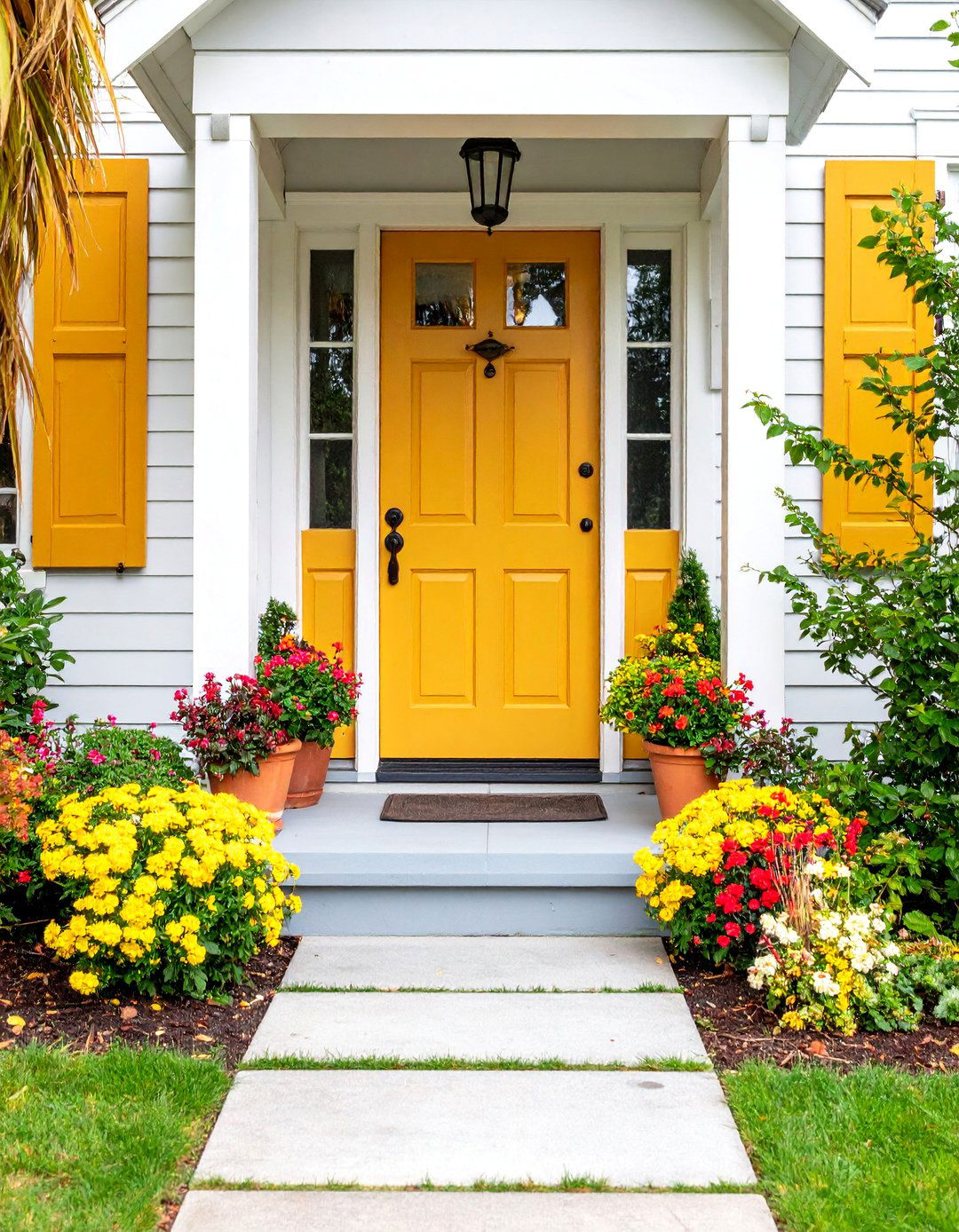
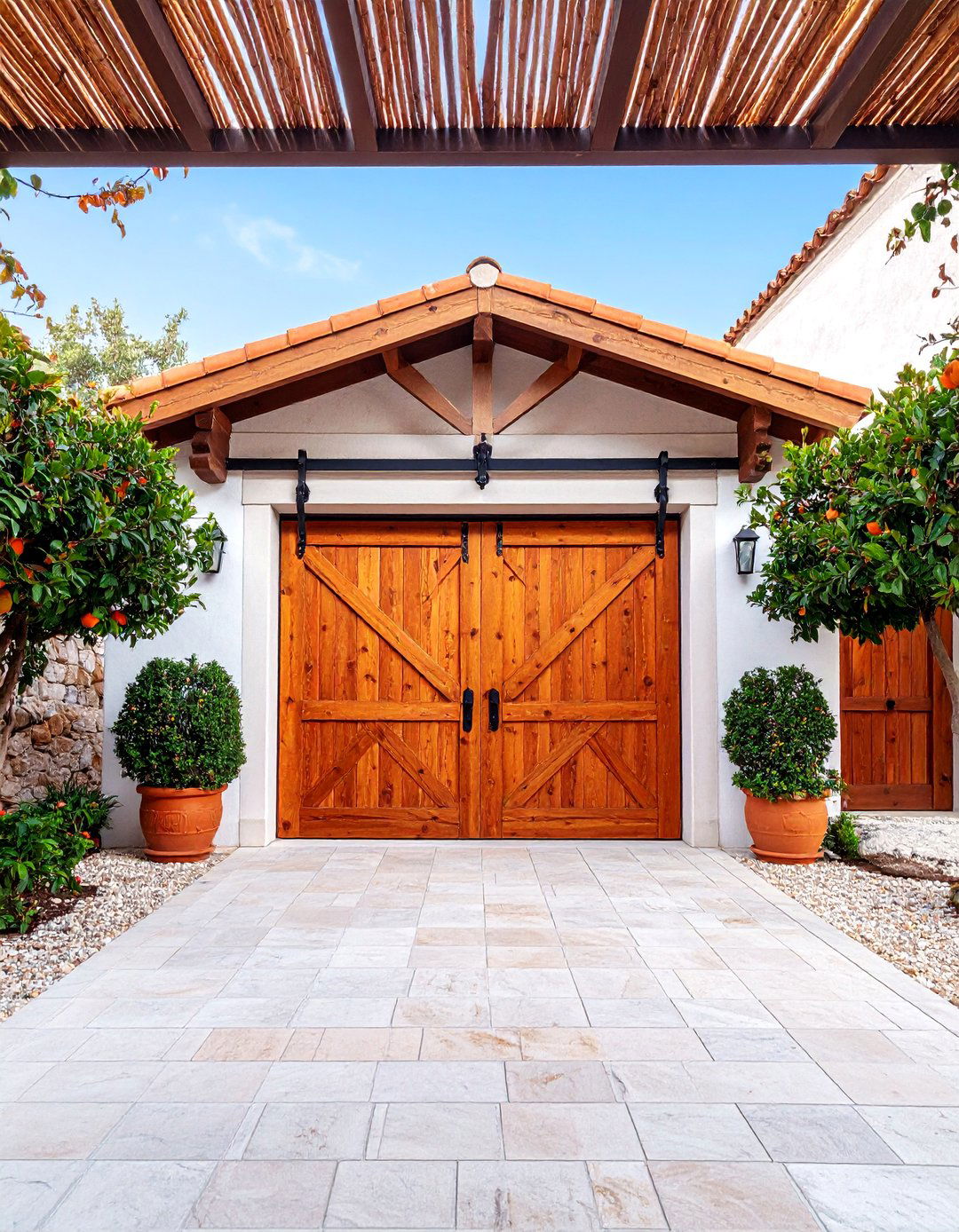

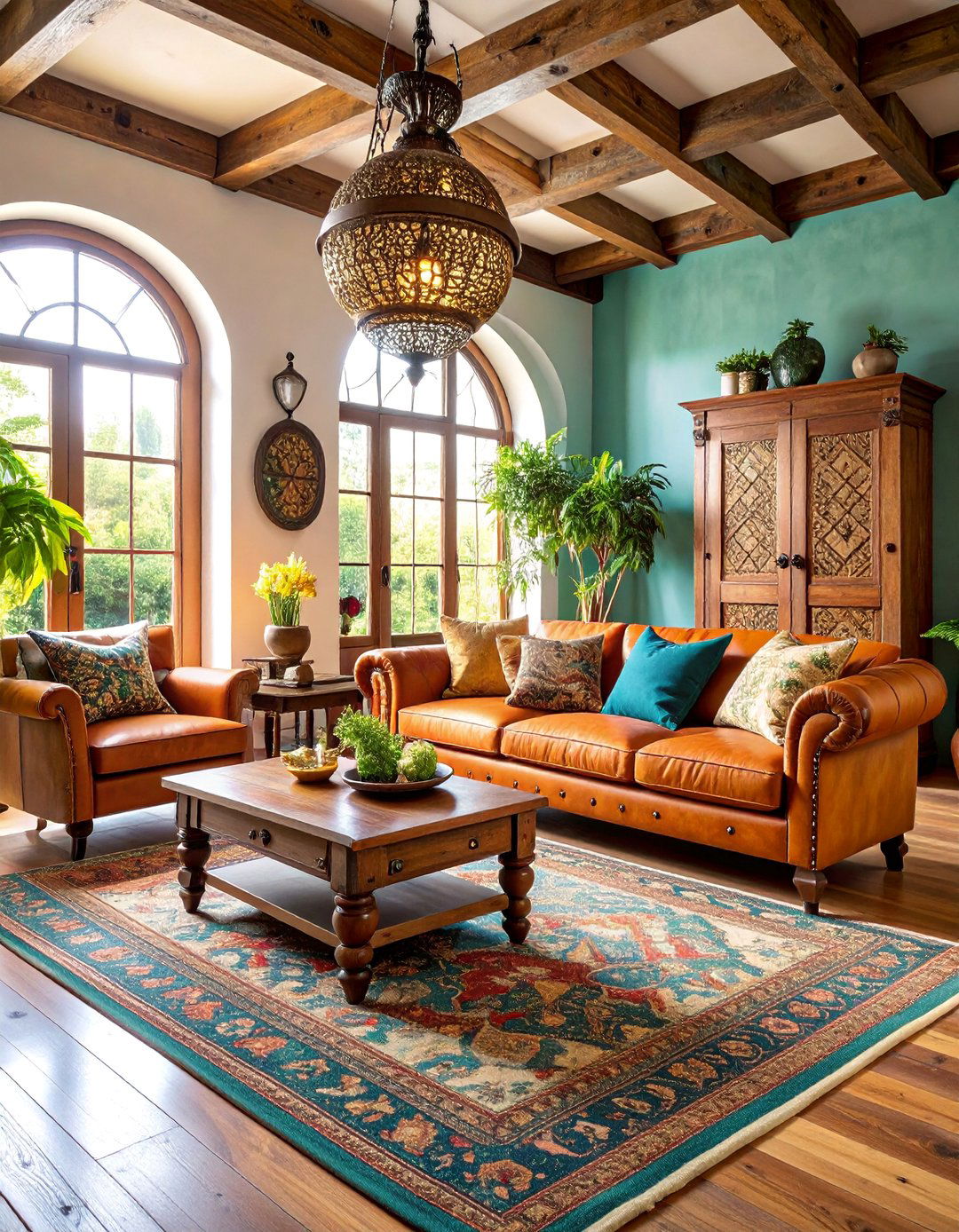
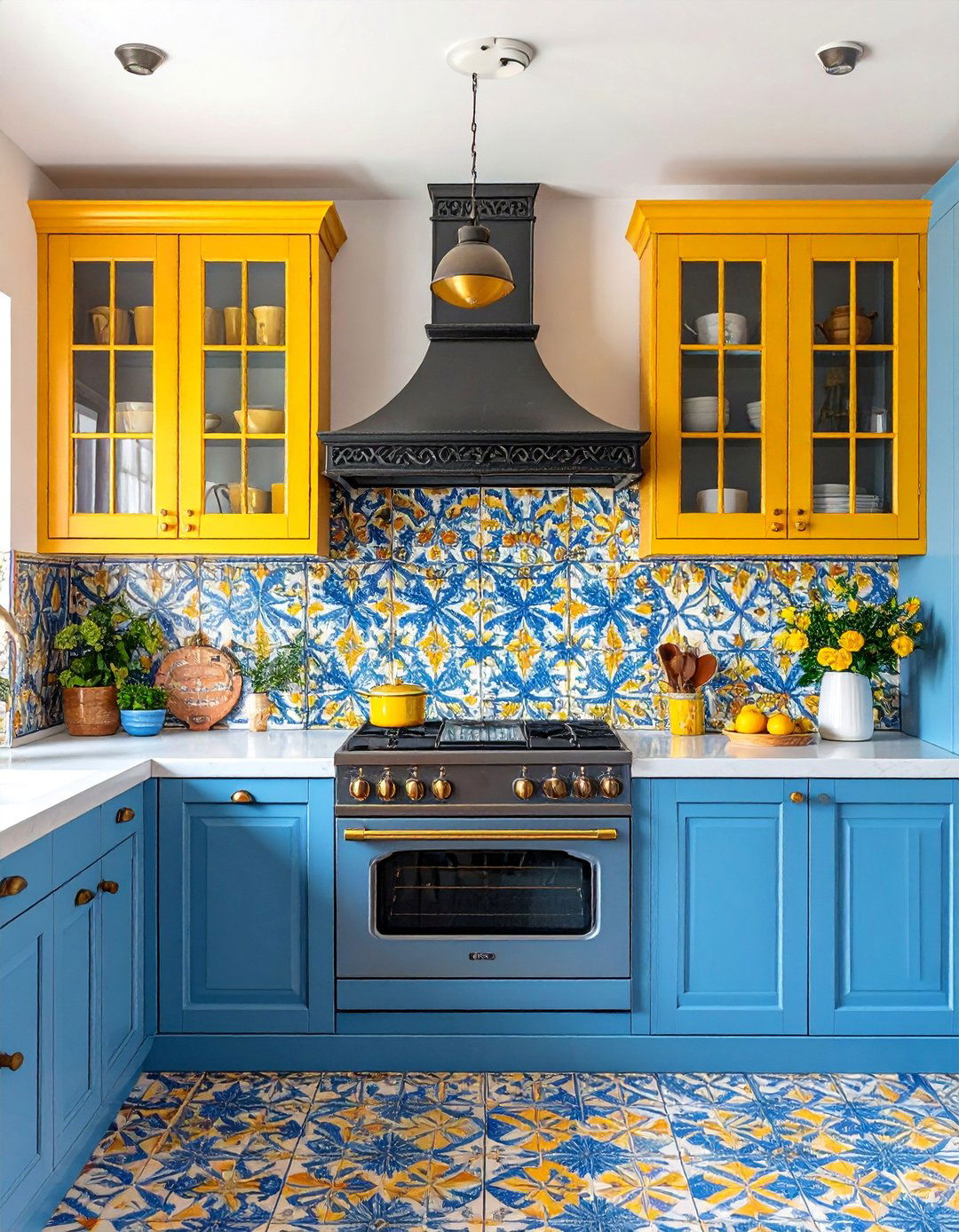
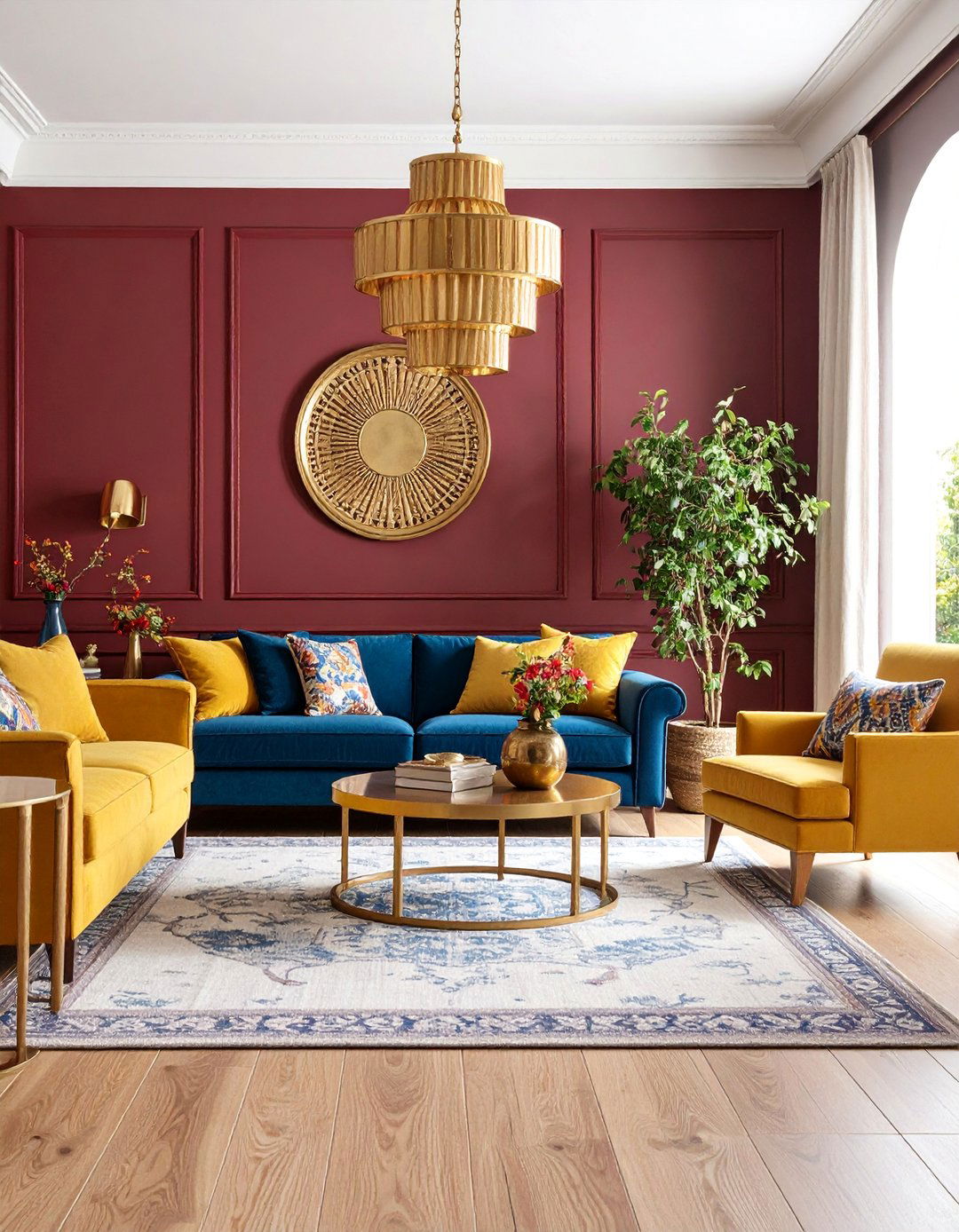
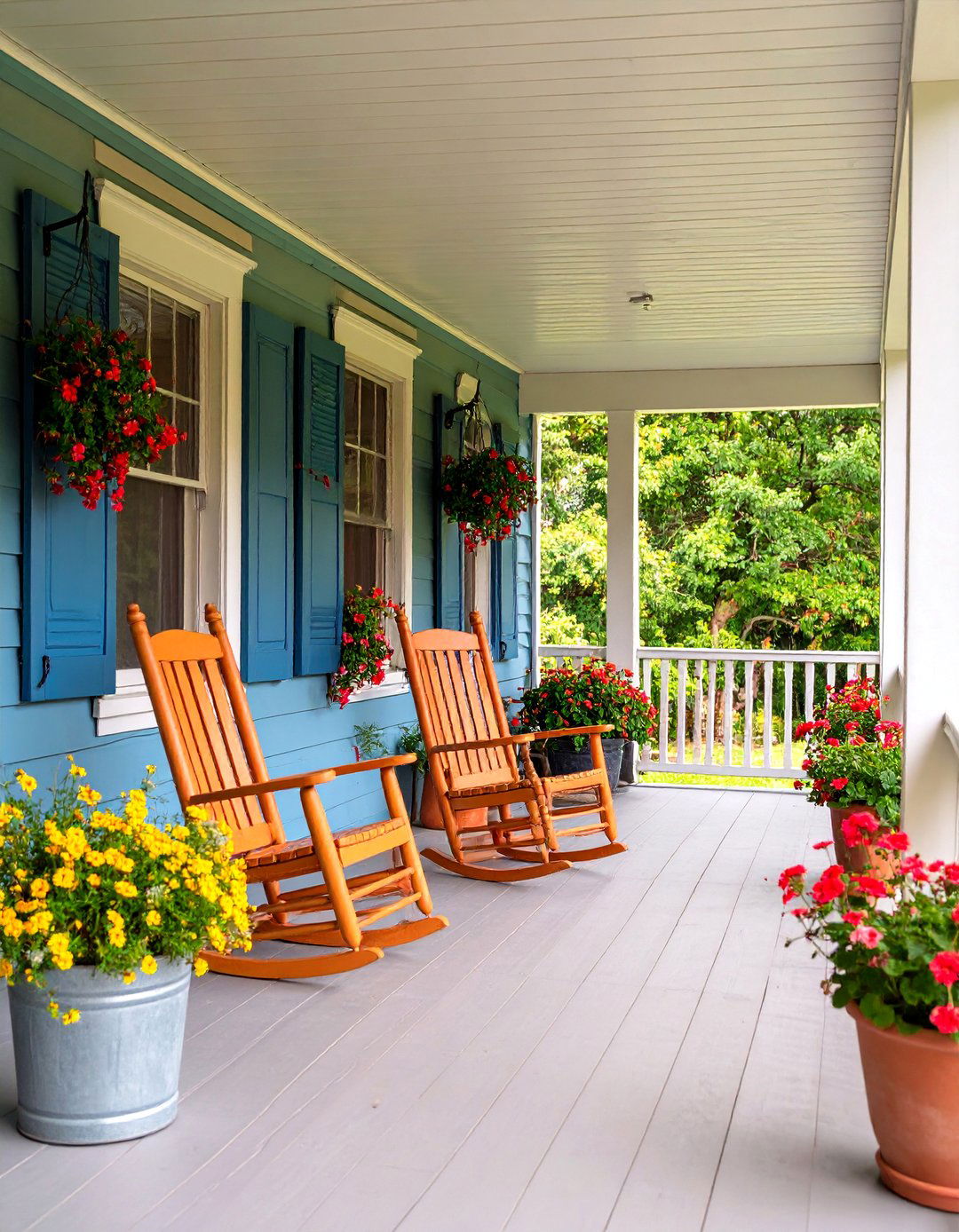




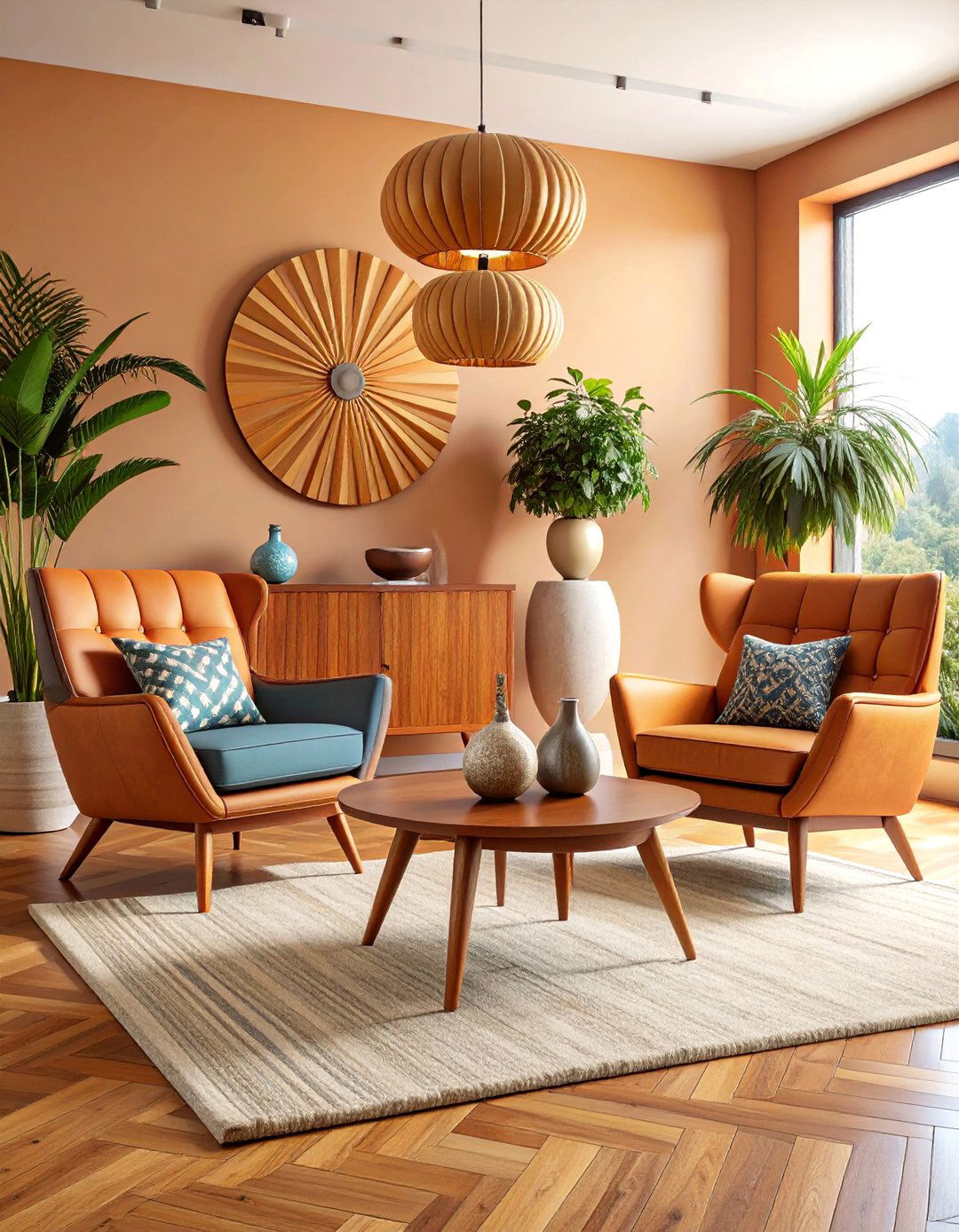
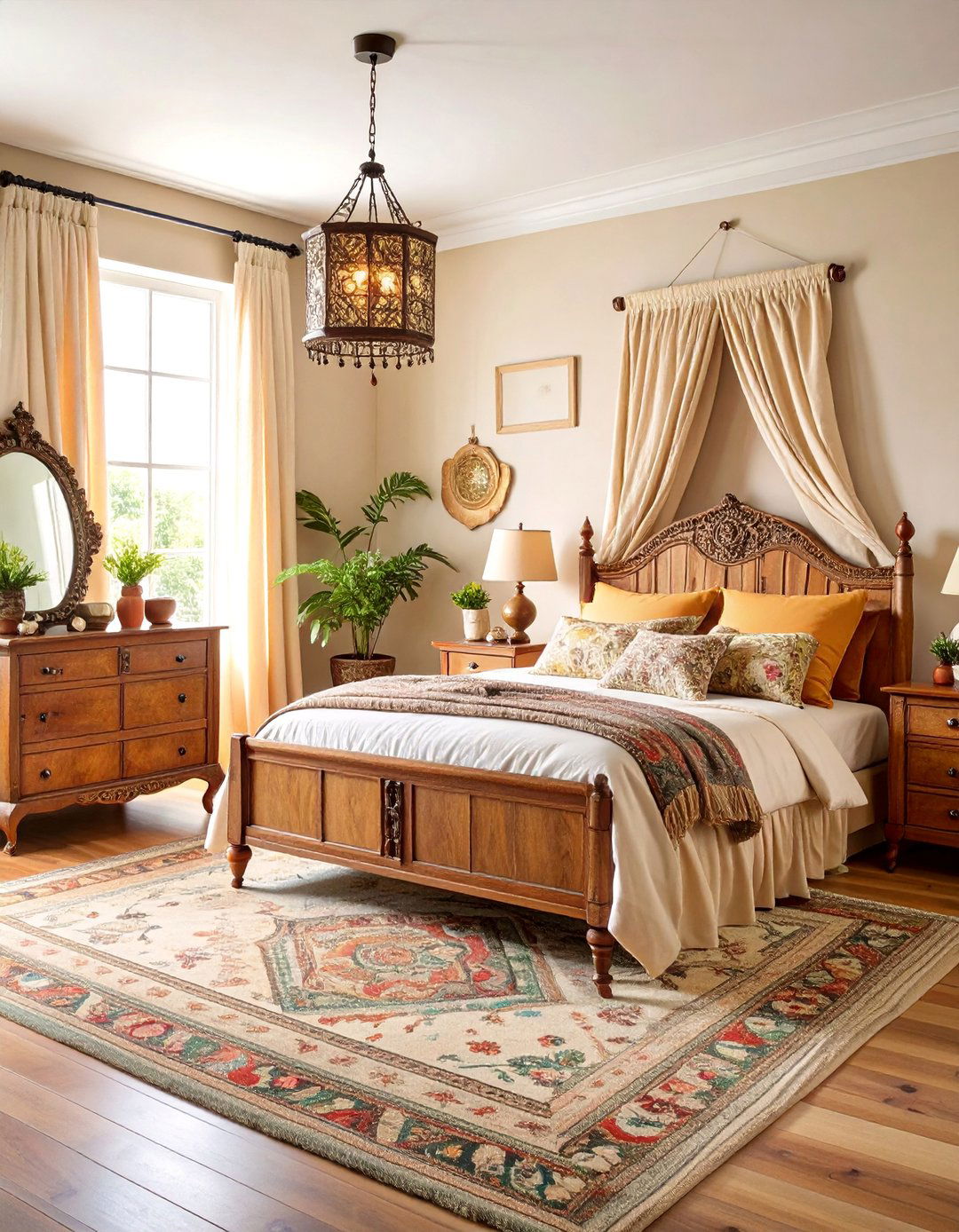
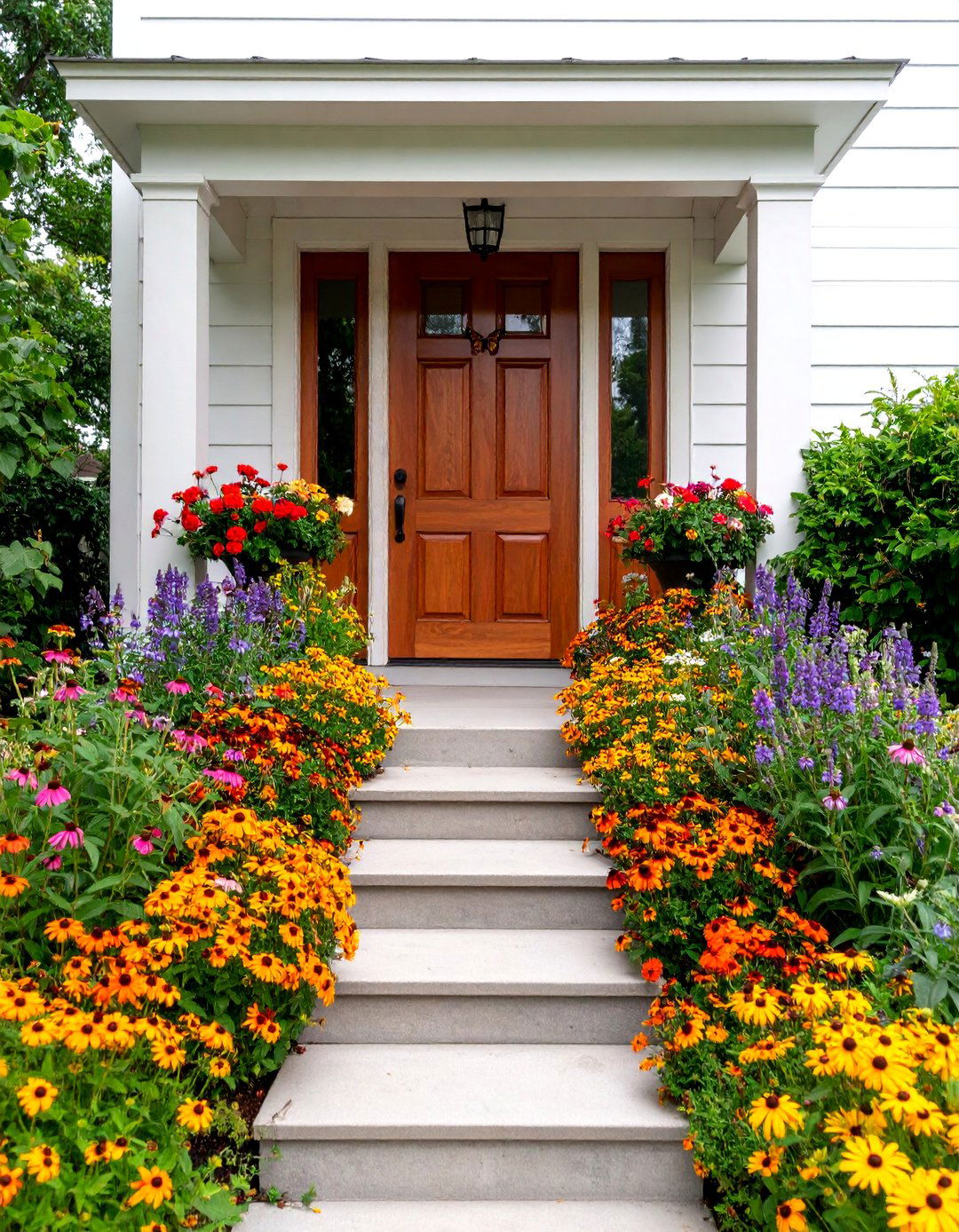

Leave a Reply